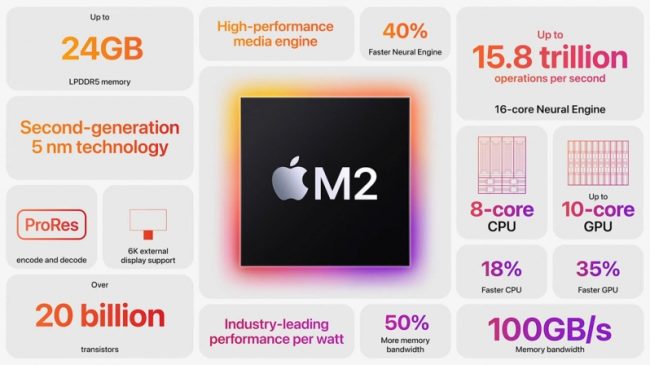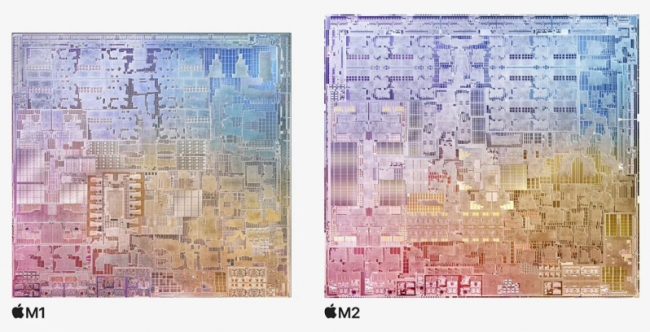„Apple“ atskleidė „M2“ lustus
„Apple“ pristatė antrosios kartos „M2“ procesorius, kuriuos gaminant naudojama antrosios kartos 5 nm litografija. Atminties posistemė pasikeitė ir naujasis „Apple M2“ lustas gali palaikyti iki 24 GB LPDDR5 atminties per 128 bitų atminties magistralę, todėl, palyginti su „Apple M1“ lustu, atminties pralaidumas padidėjo 50 %. Kalbant apie procesoriaus branduolius, „Apple M2“ žada 18 % didesnę spartą, 35 % didesnį grafikos našumą ir 40 % spartesnį naują neuroninį variklį.
„Apple M2“ luste yra daugiau nei 20 mlrd. tranzistorių, t. y. 25 % daugiau nei „Apple M1“ luste. Šie tranzistoriai naudojami siekiant padidinti spartą įvairiuose užduotyse. „Apple M2“ lustas pirmiausia bus montuojamas atnaujintose „Apple“ 13 colių „Macbook Pro“ sistemose.
Press Release – Apple unveils M2, taking the breakthrough performance and capabilities of M1 even further
Apple today announced M2, beginning the next generation of Apple silicon designed specifically for the Mac. Built using second-generation 5-nanometer technology, M2 takes the industry-leading performance per watt of M1 even further with an 18 percent faster CPU, a 35 percent more powerful GPU, and a 40 percent faster Neural Engine. It also delivers 50 percent more memory bandwidth compared to M1, and up to 24 GB of fast unified memory. M2 brings all of this—plus new custom technologies and greater efficiency—to the completely redesigned MacBook Air and updated 13-inch MacBook Pro.
„M2 starts the second generation of M-series chips and goes beyond the remarkable features of M1,“ said Johny Srouji, Apple’s senior vice president of Hardware Technologies. „With our relentless focus on power-efficient performance, M2 delivers a faster CPU, GPU, and Neural Engine. And along with higher memory bandwidth and new capabilities like ProRes acceleration, M2 continues the tremendous pace of innovation in Apple silicon for the Mac.“
The system-on-a-chip (SoC) design of M2 is built using enhanced, second-generation 5-nanometer technology, and consists of 20 billion transistors—25 percent more than M1. The additional transistors improve features across the entire chip, including the memory controller that delivers 100 GB/s of unified memory bandwidth—50 percent more than M1. And with up to 24 GB of fast unified memory, M2 can handle even larger and more complex workloads.
Faster Power-Efficient Performance
The new CPU features faster performance cores paired with a larger cache, while the efficiency cores have been significantly enhanced for even greater performance gains. Together, they deliver 18 percent greater multithreaded performance than M1, so M2 can rip through CPU-intensive tasks using very little power, like creating music with layers of effects or applying complex filters to photos. Compared with the latest 10-core PC laptop chip, the CPU in M2 provides nearly twice the performance at the same power level. And, M2 delivers the peak performance of the PC chip while using just a quarter of the power. When compared to the latest 12-core PC laptop chip—which needs dramatically more power to deliver an increase in performance and is therefore found in thicker, hotter, more noisy systems with less battery life—M2 provides nearly 90 percent of the peak performance of the 12-core chip while using just one-fourth the power.
M2 also features Apple’s next-generation GPU with up to 10 cores—two more than M1. Combined with a larger cache and higher memory bandwidth, the 10-core GPU delivers a big boost in graphics performance, bringing up to 25 percent higher graphics performance than M1 at the same power level, and up to 35 percent better performance at its max power. Compared with the integrated graphics of the latest PC laptop chip, the GPU in M2 delivers 2.3x faster performance at the same power level, and matches its peak performance using a fifth of the power. The higher performance per watt from M2 enables systems to have exceptional battery life, and run cool and quietly, even when playing graphics-intensive games or editing massive RAW images.
Apple’s Next-Generation Custom Technologies
M2 brings Apple’s latest custom technologies to the Mac, enabling new capabilities, better security, and more:
– The Neural Engine can process up to 15.8 trillion operations per second—over 40 percent more than M1.
– The media engine includes a higher-bandwidth video decoder, supporting 8K H.264 and HEVC video.
– Apple’s powerful ProRes video engine enables playback of multiple streams of both 4K and 8K video.
– Apple’s latest Secure Enclave provides best-in-class security.
– A new image signal processor (ISP) delivers better image noise reduction.
macOS, M2, and Apps
macOS has been designed for Apple silicon, and the combination of macOS Monterey and the powerful new M2 delivers breakthrough performance and productivity for users. Mac computers powered with Apple silicon have access to the largest collection of apps ever for Mac, including iPhone and iPad apps that can run on Mac, and universal apps that unlock the full power of M-series chips.
macOS Ventura, coming this fall, will also take full advantage of M2, bringing new features including Stage Manager, and powerful new capabilities with Continuity Camera and Handoff in FaceTime. macOS Ventura also includes big updates to Safari, Mail, Messages, Spotlight, and more.
Apple Silicon and the Environment
The power-efficient performance of M2 helps the new MacBook Air and 13-inch MacBook Pro meet Apple’s high standards for energy efficiency. Today, Apple is carbon neutral for global corporate operations, and by 2030, plans to have net-zero climate impact across the entire business, which includes manufacturing supply chains and all product life cycles. This means that every chip Apple creates, from design to manufacturing, will be 100 percent carbon neutral.



Sulaukėm naujo dizaino Air’o. Įdomu, ar keisis kitų modelių dizainas artimoje ateityje. Naujasis Air’as seka iMac’o dizainą. Taigi logiški variantai: 1. dizaino unifikacija, t.y. dizaino kodo perkėlimas į Pro laptopų modelius; 2. išskyrimas dizaino, kaip casual (Air, iMac, etc.) ir Pro (MacBook Pro, iMac Pro, etc.). Galbūt rugsėjį pamatysime kažkokią iPhone evoliuciją, to įtakoje. Nesekiau pastaruoju metu iPhone nutekinimų, tai negaliu aiškiau spręsti. Be to, dažnai leak’ai sau, relyzai sau 🙂
Man tai idomiau, ar pasitvirtins gandai, jog M2 Pro/Max/Ultra bus ant TSMC N3 🙂
Teko šiek tiek pasidomėti, kai parašei. Man pirma mintis, kad nafik Abolys darys tos pačios kartos (kaip ir) čipus ant skirtingų litografijų. Kai kas nete man pritaria, kai kas pažymi, kad yra buvę skirtingų litografijų. Tik tiek, kad minima ir tai, jog dabar procesas kaip ir sulėtėjęs, lėčiau keičiasi litografijos, tai ir dabar gali būti ant to paties kurpalio išausti lustai.